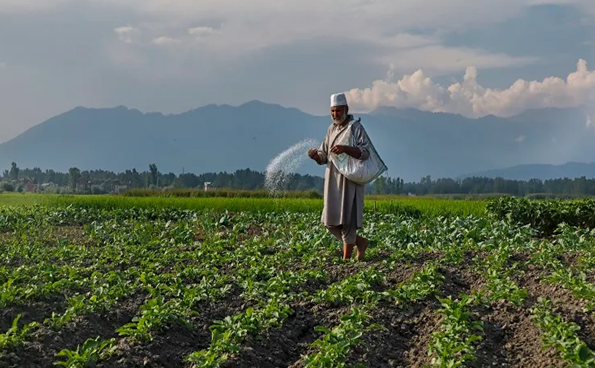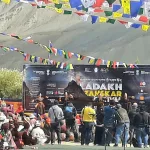The Kashmir Valley, known for its stunning landscapes and temperate climate, faces unique challenges when it comes to agricultural activities. As the autumn leaves fall and the air turns crisp, farmers across the region begin the vital task of sowing Rabi crops, which are grown during the winter season and harvested in spring. Despite the valley’s natural beauty, cultivating crops in this region is far from easy, particularly due to the harsh climatic conditions and prolonged chilling periods that the region experiences. However, through perseverance and the adoption of improved crop varieties, the farmers of Kashmir continue to sow the seeds of prosperity, ensuring both food security and economic returns.
The Rabi season in Kashmir typically extends from October to December, characterized by the cultivation of winter crops. This season is crucial for the region’s agriculture due to the cool climate, which supports the growth of a variety of crops that thrive in lower temperatures.
Key aspects of Rabi season in Kashmir
Sowing Period: Crops are usually sown from October to December. The sowing process begins right after the Kharif crops (like paddy and maize) are harvested.
Climatic Conditions; Cool temperatures: Kashmir experiences chilly winters, and many Rabi crops benefit from the cold and frost. However, excessive snowfall or prolonged cold spells can sometimes delay sowing or harm early-stage crops.
Irrigation dependence: Unlike Kharif crops that rely heavily on monsoons, Rabi crops depend more on irrigation from rivers, canals, and tube wells since precipitation is relatively lower during this time.
Major Rabi Crops:
- Oilseeds: Mustard is widely cultivated.
- Fodder: Crops like Oats are also grown during this season.
- Vegetables: Various winter vegetables, such as Peas, Saag (Khanyari and G.M. Dari), spinach, garlic etc. are grown extensively.
- Saffron: Though cultivated in autumn, saffron is harvested during the Rabi season, particularly in districts like Pulwama (Pampore).
Harvesting
The harvesting of Rabi crops begins in March-May, depending on the crop and local conditions. By this time, temperatures gradually rise, signalling the end of winter and providing favourable conditions for crop maturity.
Challenges
- Frost and snowfall: Extreme cold and heavy snowfall can damage tender plants or delay sowing.
- Limited irrigation resources: Due to lower precipitation in winter, water management becomes critical.
The Rabi season in Kashmir provides a critical window for growing food crops that support the region’s agrarian economy and ensure food security during the winter months.
Sowing Rabi Crops in Temperate Conditions
The temperate climate of the Kashmir Valley presents both opportunities and challenges for Rabi farming. Crops like oilseeds (mustard), oats (fodder), peas, and garlic are commonly sown during this season. However, the valley’s cold winters and frost conditions demand precise timing and careful crop selection to ensure successful growth and productivity.
Mustard (Oilseeds)
Mustard (Brassica Spp.), a significant oilseed crop in Kashmir, is usually sown in Mid-October or LateOctober. This crop thrives in the valley’s cold winters, but its growth is often hampered by frost and cold waves that persist throughout the winter months. To mitigate the challenges of frost and chilling injuries during the Rabi season, farmers in Kashmir are adopting improved mustard varieties such as SS-II and COS 101. These varieties offer greater resistance to cold stress, helping ensure better crop survival, improved yields, and higher economic returns. This shift to more resilient mustard varieties is part of the farmers’ strategy to adapt to the region’s harsh winter conditions while maintaining agricultural productivity. The prolonged cold in the valley means that sowing must be done with precision to avoid crop damage from early frosts. Additionally, mustard plants benefit from cold weather during their early stages, but extreme cold can stunt growth. By using high-yield, frost-resistant mustard varieties, farmers can achieve robust yields even under challenging conditions.
In the temperate climate of Kashmir, mustard cultivation requires varieties that can withstand cold temperatures, frost, and chilling injuries while delivering good yields. Below are some mustard varieties well-suited for Kashmir’s conditions:
SS-II
- Characteristics: Known for its resistance to chilling injuries and frost damage, SS-II is one of the improved varieties that farmers in Kashmir are increasingly adopting. It is also known for higher oil content and yield stability.
- Maturity: Medium-duration.
- Use: Primarily grown for oilseed production, with good potential for high returns.
COS 101
- Characteristics: COS 101 is another cold-resistant variety gaining popularity in Kashmir. It performs well under cold and frost conditions, ensuring higher yields and more reliable crop survival.
- Maturity: Medium-late duration.
- Use: Cultivated for its oil content and resistance to frost.
PM-21
- Characteristics: A cold-tolerant variety with high seed and oil yield, Pusa Mustard-21 is a preferred option for temperate climates. It has a strong resistance to frost and provides consistent yields.
- Maturity: Early-maturing (85-90 days).
- Use: Grown for oil extraction and suitable for cultivation in the colder regions of Kashmir.
RH-30
- Characteristics: A variety that shows good adaptability to Kashmir’s climatic conditions, RH-30 is moderately resistant to frost and offers good yields under temperate conditions.
- Maturity: Medium duration.
- Use: Preferred for oil production due to its high oil content.
These mustard varieties help ensure that farmers in Kashmir can secure better yields and returns while mitigating the risks posed by cold temperatures, frost, and chilling injuries during the Rabi season.
Oats (Fodder)
Oats (Avena sativa) is another important Rabi crop in the Kashmir Valley, primarily grown for fodder to feed livestock. Oats are well-suited to the valley’s cold environment, but prolonged frost periods and snowfall often pose challenges during the growing season. To ensure adequate fodder supply, farmers in Kashmir are adopting cold-tolerant oat varieties such as Sabzar, SFO-1 that are better equipped to withstand freezing temperatures and snow cover. Farmers in Kashmir are indeed turning to cold-tolerant oat varieties like Sabzar and SFO-1 to secure an adequate supply of fodder during the harsh winter months.
These varieties are specially bred to handle freezing temperatures and can thrive even under snow cover. This adaptation ensures that the farmers not only have a reliable fodder source during the cold season but also benefit from good yields, making these varieties a practical choice for sustaining livestock in the region’s challenging winter conditions. Oats require good soil moisture for proper germination, and since the valley experiences periodic snowfall, it provides the necessary water. However, the intense cold can delay germination and limit the availability of fresh fodder. Improved oat varieties with frost tolerance are crucial for maintaining healthy fodder production and keeping livestock well-fed during the harsh winter months.
For the temperate conditions of Kashmir, oat (Avena sativa) varieties are selected for their adaptability to cold temperatures, frost resistance, and high fodder or grain yields. Oats are primarily grown for fodder in the region due to their ability to thrive in the colder climate. Here are some oat varieties well-suited for temperate Kashmir:
Sabzar
- Characteristics: A popular oat variety in Kashmir, Sabzaris cold-tolerant and capable of withstanding freezing temperatures and snow cover. It provides high-quality fodder with good biomass yield.
- Use: Primarily cultivated for fodder due to its nutritious forage.
SFO-1
- Characteristics: This is another cold-tolerant variety favored by farmers in Kashmir. SFO-1 can withstand frost and is known for its high green fodder and dry matter production, making it a reliable option for livestock feed.
- Use: Grown for fodder, especially during the winter months.
Kent
- Characteristics: A well-known variety for its cold tolerance, Kent is widely grown in temperate climates. It is a high-yielding variety, producing both grain and fodder, with good resistance to cold and frost.
- Use: Suitable for both grain and fodder production.
OS-6
- Characteristics: This variety is highly adaptable to colder regions and can withstand frost. OS-6 produces high green fodder and dry matter yields, making it a good choice for Kashmir’s climate.
- Use: Primarily cultivated for fodder.
HFO-114
- Characteristics: A high-yielding variety with good tolerance to cold temperatures, HFO-114 is known for producing high-quality forage. It can handle the cold, snowy winters in Kashmir.
- Use: Grown for fodder.
KO-1
- Characteristics: KO-1 is an oat variety that is well-suited for colder regions.Released for its adaptability to the local agro-climatic conditions, KO-1 offers good resistance to common diseases.
- Use: Provides high nutritional value for livestock.
These oat varieties are chosen by farmers in Kashmir to ensure a reliable supply of fodder during the harsh winter months. Their ability to thrive in cold, frost-prone conditions while providing high yields makes them essential for sustaining livestock in the region.
Peas
Peas (Pisum sativum) are a popular Rabi crop grown in the Kashmir Valley due to their high nutritional value and market demand. However, like other crops, peas are vulnerable to the valley’s prolonged cold spells. Frost-resistant varieties of peashave become essential in mitigating the damage caused by extended frost periods, ensuring higher yields and preventing crop loss.
Peas are typically sown in mid to late October, but unpredictable weather, such as sudden frost or snowfall, can severely impact their growth. The development of high-yield pea varieties that can flourish even under low temperatures is a game-changer for farmers in the valley, helping them maximize returns despite the region’s cold climate.
In temperate conditions like those found in Kashmir, certain pea (Pisum sativum) varieties are well-suited for cultivation, especially during the Rabi season. These varieties are selected for their adaptability to the cooler climate, frost tolerance, and high yields. Some of the commonly recommended pea varieties for Kashmir include:
Arkel
- Maturity: Early maturing (about 60-65 days).
- Characteristics: It is a dwarf variety with high yields and sweet, tender pods. Arkel is preferred for early sowing in temperate climates and has good tolerance to cold.
- Use: Mainly grown for fresh market and kitchen gardening.
AP-3
- Maturity: Medium duration (65-70 days).
- Characteristics: AP-3 is a widely grown variety in Kashmir known for its high yield potential and good quality pods. It is moderately resistant to frost.
- Use: Suitable for fresh consumption and canning purposes.
Bonneville
- Maturity: Mid-season (75-80 days).
- Characteristics: This variety produces large, smooth peas with good flavor and is relatively cold-tolerant, making it ideal for Kashmir’s temperate conditions.
- Use: Primarily grown for fresh market and processing.
Azad P-1
- Maturity: Early maturing (55-60 days).
- Characteristics: This is an early-maturing pea variety with high yields and good cold tolerance. It is suitable for early sowing in cold conditions.
- Use: Primarily for fresh market.
VL Matar-42
- Maturity: Medium duration (60-65 days).
- Characteristics: This variety is suitable for cold climates and has good resistance to frost. It produces high yields with uniform, well-filled pods.
- Use: Fresh market and processing.
PB-89
- Maturity: Late maturing (80-85 days).
- Characteristics: It has good tolerance to low temperatures and provides excellent yields of large, high-quality peas.
- Use: Fresh market and suitable for canning.
These varieties help farmers in Kashmir meet the demands of both fresh consumption and processing industries while ensuring good productivity under cold conditions.
Garlic
Garlic (Allium sativum), a principal crop in the region, is widely cultivated during the Rabi season due to its high demand both locally and in markets across India. However, the freezing temperatures and frost conditions prevalent in the Kashmir Valley during winter make garlic cultivation a challenging endeavour. Frost-resistant garlic varieties are essential for ensuring that the crop can survive the harsh winter and develop properly by the time spring arrives.
Garlic is typically sown in late September or early October to give it enough time to establish before the severe cold sets in. Despite the challenges, garlic is one of the most lucrative crops for farmers in the valley, especially when grown using improved varieties that are more resilient to frost and low temperatures.In temperate regions like Kashmir, garlic is widely grown due to its adaptability to cooler climates. SKUAST-Kashmir (Sher-e-Kashmir University of Agricultural Sciences and Technology) has released several garlic varieties suitable for temperate conditions in Kashmir. Here are some notable ones:
Kashmir Local Garlic
This variety is well-adapted to the local agro-climatic conditions and is known for its good flavor and storage qualities.
KG-1
Released for its high yield potential and good bulb quality, KG-1 is adapted to the temperate climate of Kashmir and is known for its disease resistance.
KG-2
This variety offers improved yield and quality traits compared to traditional local varieties. It is suitable for cultivation in the temperate regions of Kashmir.
SKUAST-K Garlic
This variety was developed specifically for the hilly and temperate regions, focusing on yield, bulb size, and resistance to common garlic diseases.
These varieties have been developed through extensive research and breeding programs to ensure they meet the specific climatic and agronomic conditions of temperate Kashmir, providing farmers with options that enhance yield and quality.
Challenges of Harsh Climatic Conditions
The Kashmir Valley experiences some of the most challenging winter conditions for agriculture. Prolonged chilling and frost can significantly impact the growth of crops, causing delays in germination, stunting growth, and reducing yields. The region often experiences cold waves, heavy snowfall, and sub-zero temperatures that persist for several months, creating difficult conditions for both crop cultivation and livestock management.
- Frost Damage: Frost is one of the most common threats to Rabi crops, particularly during the early stages of growth. If not properly managed, frost can kill young plants or severely stunt their growth.
- Prolonged Snow Cover: The valley often receives heavy snowfall, which can cover the crops for extended periods, reducing the amount of sunlight they receive and delaying their growth.
- Soil Moisture Issues: While snowfall helps maintain soil moisture, excessive cold can cause the soil to freeze, making it difficult for roots to absorb water and nutrients.
Need for Improved Varieties for Higher Returns
To combat the challenges posed by the valley’s frost conditions and harsh winters, there is an increasing need for the adoption of improved crop varieties. These varieties are bred to be frost-resistant, cold-tolerant, and capable of producing higher yields despite the region’s extreme weather.
- Frost-resistant Varieties: Crops like mustard, oats, peas, and garlic can thrive in the valley’s conditions when farmers utilize varieties that are specifically designed to withstand prolonged frost and freezing temperatures.
- High-Yielding Varieties: Improved varieties not only resist the cold but also offer higher yields, ensuring that farmers can achieve better economic returns even when faced with difficult growing conditions.
- Shorter Growing Cycles: Many of these improved varieties have shorter growing cycles, allowing them to mature faster and reduce the risk of being exposed to extreme cold for prolonged periods.
By adopting these improved varieties, farmers in the Kashmir Valley are not only overcoming the challenges of their harsh environment but also achieving higher profitability. With proper planning, timely sowing, and the use of modern agricultural techniques, the valley’s Rabi crops have the potential to thrive even in the face of prolonged chilling and frost.
Despite the harsh climatic conditions and the many challenges that come with farming in the Kashmir Valley, the cultivation of Rabi crops like mustard, oats, peas, and garlic continues to be a source of prosperity for the region. By adopting improved frost-resistant varieties and leveraging modern agricultural techniques, farmers are not only securing their livelihoods but also contributing to the region’s overall economic well-being. The seeds of prosperity are truly being sown, and with continued innovation and resilience, the future of agriculture in Kashmir looks promising.
(The Author is Agriculture Extension Officer, Agriculture Zone Pulwama. Feedback: [email protected])








